Impact of Corporate Governance on Risk Management Practices in ASEAN
VerifiedAdded on 2022/09/09
|8
|3505
|14
Essay
AI Summary
This essay examines the impact of corporate governance on risk management practices within ASEAN economies. It begins with an introduction to corporate governance and its role in regulating businesses, followed by a literature review that describes ASEAN firms and the evolution of corporate governance and risk management within them. The essay assesses the effect of corporate governance norms on risk management practices for non-financial firms in ASEAN countries, highlighting the importance of governance structure, board structure, director appointments, director duties, and risk governance. The essay then discusses relevant theories, including agency and stewardship theories, that influence the relationship between corporate governance and risk management. Finally, it addresses future directions and implications for the relationship between corporate governance and risk management in emerging ASEAN countries, emphasizing the importance of ethical standards, risk assessment, and stakeholder engagement. The essay utilizes recent academic papers and case studies to support its arguments.
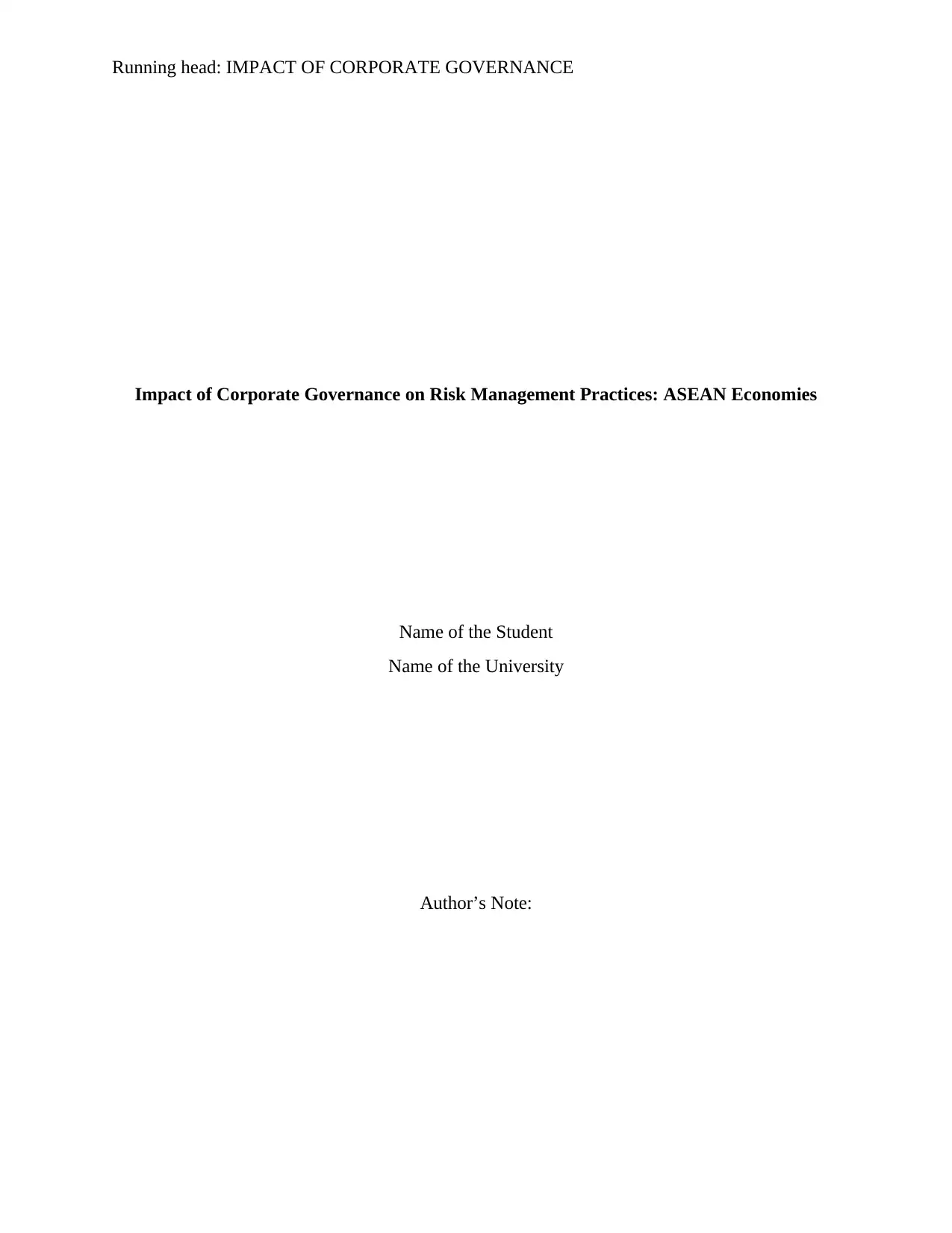
Running head: IMPACT OF CORPORATE GOVERNANCE
Impact of Corporate Governance on Risk Management Practices: ASEAN Economies
Name of the Student
Name of the University
Author’s Note:
Impact of Corporate Governance on Risk Management Practices: ASEAN Economies
Name of the Student
Name of the University
Author’s Note:
Paraphrase This Document
Need a fresh take? Get an instant paraphrase of this document with our AI Paraphraser
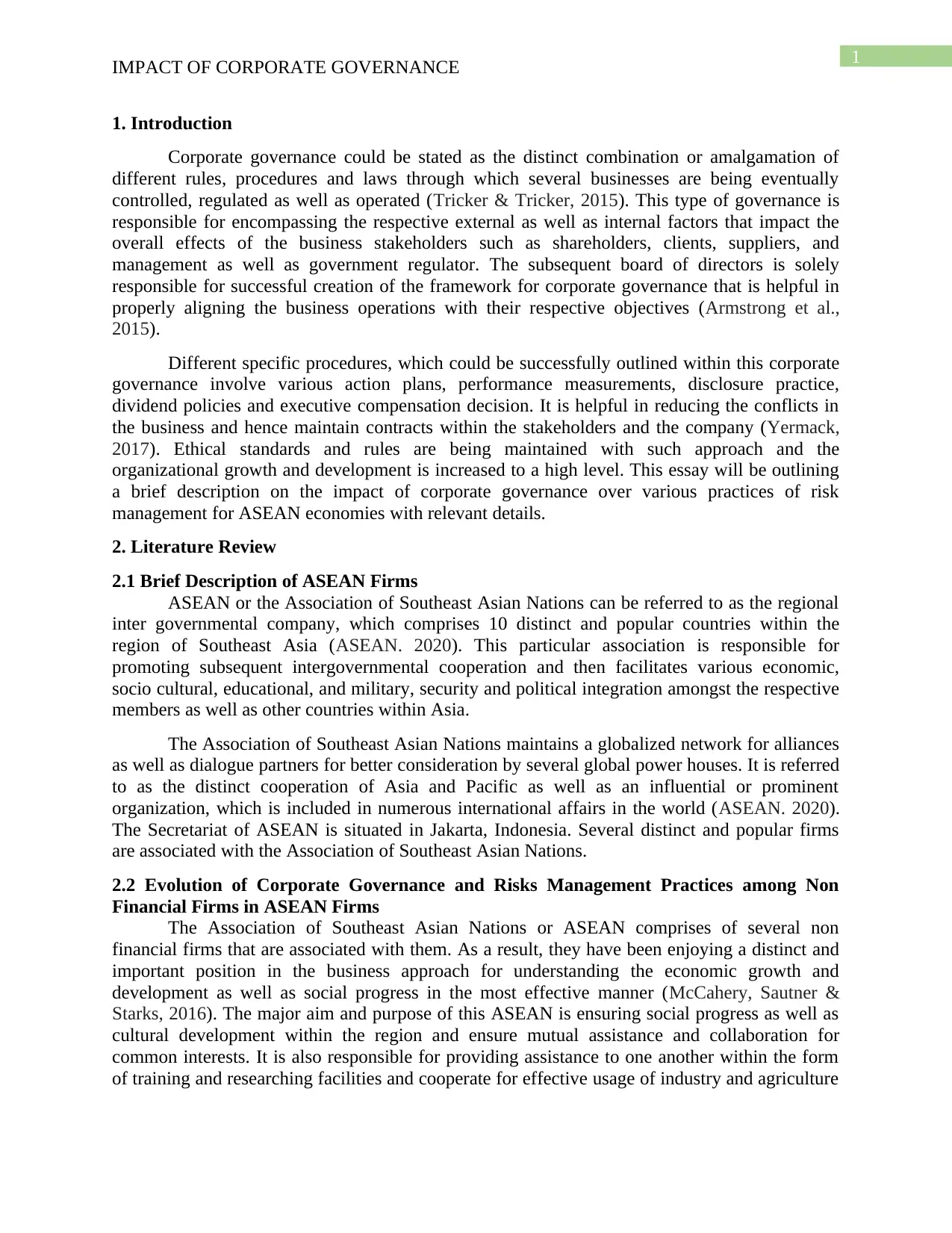
1
IMPACT OF CORPORATE GOVERNANCE
1. Introduction
Corporate governance could be stated as the distinct combination or amalgamation of
different rules, procedures and laws through which several businesses are being eventually
controlled, regulated as well as operated (Tricker & Tricker, 2015). This type of governance is
responsible for encompassing the respective external as well as internal factors that impact the
overall effects of the business stakeholders such as shareholders, clients, suppliers, and
management as well as government regulator. The subsequent board of directors is solely
responsible for successful creation of the framework for corporate governance that is helpful in
properly aligning the business operations with their respective objectives (Armstrong et al.,
2015).
Different specific procedures, which could be successfully outlined within this corporate
governance involve various action plans, performance measurements, disclosure practice,
dividend policies and executive compensation decision. It is helpful in reducing the conflicts in
the business and hence maintain contracts within the stakeholders and the company (Yermack,
2017). Ethical standards and rules are being maintained with such approach and the
organizational growth and development is increased to a high level. This essay will be outlining
a brief description on the impact of corporate governance over various practices of risk
management for ASEAN economies with relevant details.
2. Literature Review
2.1 Brief Description of ASEAN Firms
ASEAN or the Association of Southeast Asian Nations can be referred to as the regional
inter governmental company, which comprises 10 distinct and popular countries within the
region of Southeast Asia (ASEAN. 2020). This particular association is responsible for
promoting subsequent intergovernmental cooperation and then facilitates various economic,
socio cultural, educational, and military, security and political integration amongst the respective
members as well as other countries within Asia.
The Association of Southeast Asian Nations maintains a globalized network for alliances
as well as dialogue partners for better consideration by several global power houses. It is referred
to as the distinct cooperation of Asia and Pacific as well as an influential or prominent
organization, which is included in numerous international affairs in the world (ASEAN. 2020).
The Secretariat of ASEAN is situated in Jakarta, Indonesia. Several distinct and popular firms
are associated with the Association of Southeast Asian Nations.
2.2 Evolution of Corporate Governance and Risks Management Practices among Non
Financial Firms in ASEAN Firms
The Association of Southeast Asian Nations or ASEAN comprises of several non
financial firms that are associated with them. As a result, they have been enjoying a distinct and
important position in the business approach for understanding the economic growth and
development as well as social progress in the most effective manner (McCahery, Sautner &
Starks, 2016). The major aim and purpose of this ASEAN is ensuring social progress as well as
cultural development within the region and ensure mutual assistance and collaboration for
common interests. It is also responsible for providing assistance to one another within the form
of training and researching facilities and cooperate for effective usage of industry and agriculture
IMPACT OF CORPORATE GOVERNANCE
1. Introduction
Corporate governance could be stated as the distinct combination or amalgamation of
different rules, procedures and laws through which several businesses are being eventually
controlled, regulated as well as operated (Tricker & Tricker, 2015). This type of governance is
responsible for encompassing the respective external as well as internal factors that impact the
overall effects of the business stakeholders such as shareholders, clients, suppliers, and
management as well as government regulator. The subsequent board of directors is solely
responsible for successful creation of the framework for corporate governance that is helpful in
properly aligning the business operations with their respective objectives (Armstrong et al.,
2015).
Different specific procedures, which could be successfully outlined within this corporate
governance involve various action plans, performance measurements, disclosure practice,
dividend policies and executive compensation decision. It is helpful in reducing the conflicts in
the business and hence maintain contracts within the stakeholders and the company (Yermack,
2017). Ethical standards and rules are being maintained with such approach and the
organizational growth and development is increased to a high level. This essay will be outlining
a brief description on the impact of corporate governance over various practices of risk
management for ASEAN economies with relevant details.
2. Literature Review
2.1 Brief Description of ASEAN Firms
ASEAN or the Association of Southeast Asian Nations can be referred to as the regional
inter governmental company, which comprises 10 distinct and popular countries within the
region of Southeast Asia (ASEAN. 2020). This particular association is responsible for
promoting subsequent intergovernmental cooperation and then facilitates various economic,
socio cultural, educational, and military, security and political integration amongst the respective
members as well as other countries within Asia.
The Association of Southeast Asian Nations maintains a globalized network for alliances
as well as dialogue partners for better consideration by several global power houses. It is referred
to as the distinct cooperation of Asia and Pacific as well as an influential or prominent
organization, which is included in numerous international affairs in the world (ASEAN. 2020).
The Secretariat of ASEAN is situated in Jakarta, Indonesia. Several distinct and popular firms
are associated with the Association of Southeast Asian Nations.
2.2 Evolution of Corporate Governance and Risks Management Practices among Non
Financial Firms in ASEAN Firms
The Association of Southeast Asian Nations or ASEAN comprises of several non
financial firms that are associated with them. As a result, they have been enjoying a distinct and
important position in the business approach for understanding the economic growth and
development as well as social progress in the most effective manner (McCahery, Sautner &
Starks, 2016). The major aim and purpose of this ASEAN is ensuring social progress as well as
cultural development within the region and ensure mutual assistance and collaboration for
common interests. It is also responsible for providing assistance to one another within the form
of training and researching facilities and cooperate for effective usage of industry and agriculture
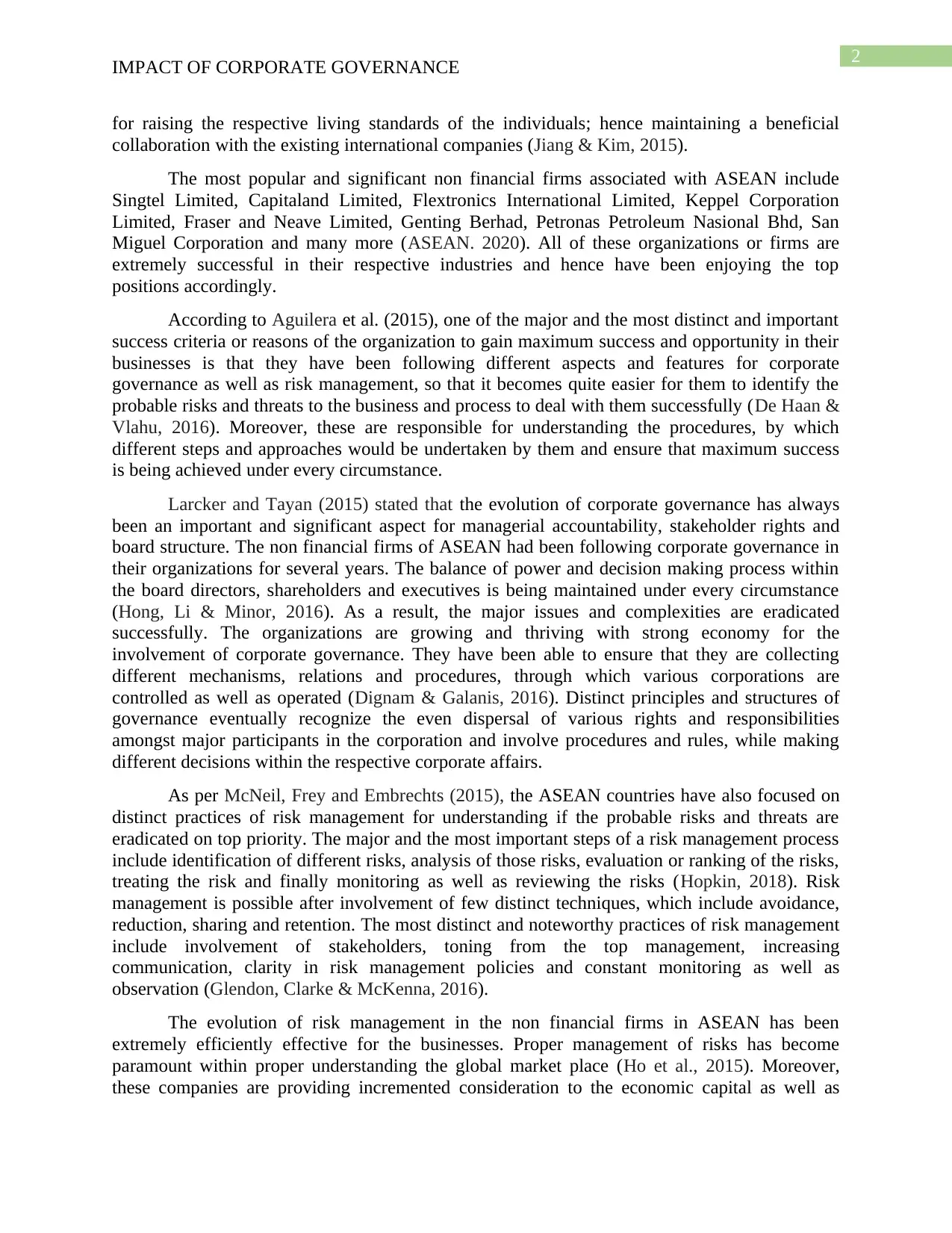
2
IMPACT OF CORPORATE GOVERNANCE
for raising the respective living standards of the individuals; hence maintaining a beneficial
collaboration with the existing international companies (Jiang & Kim, 2015).
The most popular and significant non financial firms associated with ASEAN include
Singtel Limited, Capitaland Limited, Flextronics International Limited, Keppel Corporation
Limited, Fraser and Neave Limited, Genting Berhad, Petronas Petroleum Nasional Bhd, San
Miguel Corporation and many more (ASEAN. 2020). All of these organizations or firms are
extremely successful in their respective industries and hence have been enjoying the top
positions accordingly.
According to Aguilera et al. (2015), one of the major and the most distinct and important
success criteria or reasons of the organization to gain maximum success and opportunity in their
businesses is that they have been following different aspects and features for corporate
governance as well as risk management, so that it becomes quite easier for them to identify the
probable risks and threats to the business and process to deal with them successfully (De Haan &
Vlahu, 2016). Moreover, these are responsible for understanding the procedures, by which
different steps and approaches would be undertaken by them and ensure that maximum success
is being achieved under every circumstance.
Larcker and Tayan (2015) stated that the evolution of corporate governance has always
been an important and significant aspect for managerial accountability, stakeholder rights and
board structure. The non financial firms of ASEAN had been following corporate governance in
their organizations for several years. The balance of power and decision making process within
the board directors, shareholders and executives is being maintained under every circumstance
(Hong, Li & Minor, 2016). As a result, the major issues and complexities are eradicated
successfully. The organizations are growing and thriving with strong economy for the
involvement of corporate governance. They have been able to ensure that they are collecting
different mechanisms, relations and procedures, through which various corporations are
controlled as well as operated (Dignam & Galanis, 2016). Distinct principles and structures of
governance eventually recognize the even dispersal of various rights and responsibilities
amongst major participants in the corporation and involve procedures and rules, while making
different decisions within the respective corporate affairs.
As per McNeil, Frey and Embrechts (2015), the ASEAN countries have also focused on
distinct practices of risk management for understanding if the probable risks and threats are
eradicated on top priority. The major and the most important steps of a risk management process
include identification of different risks, analysis of those risks, evaluation or ranking of the risks,
treating the risk and finally monitoring as well as reviewing the risks (Hopkin, 2018). Risk
management is possible after involvement of few distinct techniques, which include avoidance,
reduction, sharing and retention. The most distinct and noteworthy practices of risk management
include involvement of stakeholders, toning from the top management, increasing
communication, clarity in risk management policies and constant monitoring as well as
observation (Glendon, Clarke & McKenna, 2016).
The evolution of risk management in the non financial firms in ASEAN has been
extremely efficiently effective for the businesses. Proper management of risks has become
paramount within proper understanding the global market place (Ho et al., 2015). Moreover,
these companies are providing incremented consideration to the economic capital as well as
IMPACT OF CORPORATE GOVERNANCE
for raising the respective living standards of the individuals; hence maintaining a beneficial
collaboration with the existing international companies (Jiang & Kim, 2015).
The most popular and significant non financial firms associated with ASEAN include
Singtel Limited, Capitaland Limited, Flextronics International Limited, Keppel Corporation
Limited, Fraser and Neave Limited, Genting Berhad, Petronas Petroleum Nasional Bhd, San
Miguel Corporation and many more (ASEAN. 2020). All of these organizations or firms are
extremely successful in their respective industries and hence have been enjoying the top
positions accordingly.
According to Aguilera et al. (2015), one of the major and the most distinct and important
success criteria or reasons of the organization to gain maximum success and opportunity in their
businesses is that they have been following different aspects and features for corporate
governance as well as risk management, so that it becomes quite easier for them to identify the
probable risks and threats to the business and process to deal with them successfully (De Haan &
Vlahu, 2016). Moreover, these are responsible for understanding the procedures, by which
different steps and approaches would be undertaken by them and ensure that maximum success
is being achieved under every circumstance.
Larcker and Tayan (2015) stated that the evolution of corporate governance has always
been an important and significant aspect for managerial accountability, stakeholder rights and
board structure. The non financial firms of ASEAN had been following corporate governance in
their organizations for several years. The balance of power and decision making process within
the board directors, shareholders and executives is being maintained under every circumstance
(Hong, Li & Minor, 2016). As a result, the major issues and complexities are eradicated
successfully. The organizations are growing and thriving with strong economy for the
involvement of corporate governance. They have been able to ensure that they are collecting
different mechanisms, relations and procedures, through which various corporations are
controlled as well as operated (Dignam & Galanis, 2016). Distinct principles and structures of
governance eventually recognize the even dispersal of various rights and responsibilities
amongst major participants in the corporation and involve procedures and rules, while making
different decisions within the respective corporate affairs.
As per McNeil, Frey and Embrechts (2015), the ASEAN countries have also focused on
distinct practices of risk management for understanding if the probable risks and threats are
eradicated on top priority. The major and the most important steps of a risk management process
include identification of different risks, analysis of those risks, evaluation or ranking of the risks,
treating the risk and finally monitoring as well as reviewing the risks (Hopkin, 2018). Risk
management is possible after involvement of few distinct techniques, which include avoidance,
reduction, sharing and retention. The most distinct and noteworthy practices of risk management
include involvement of stakeholders, toning from the top management, increasing
communication, clarity in risk management policies and constant monitoring as well as
observation (Glendon, Clarke & McKenna, 2016).
The evolution of risk management in the non financial firms in ASEAN has been
extremely efficiently effective for the businesses. Proper management of risks has become
paramount within proper understanding the global market place (Ho et al., 2015). Moreover,
these companies are providing incremented consideration to the economic capital as well as
⊘ This is a preview!⊘
Do you want full access?
Subscribe today to unlock all pages.

Trusted by 1+ million students worldwide
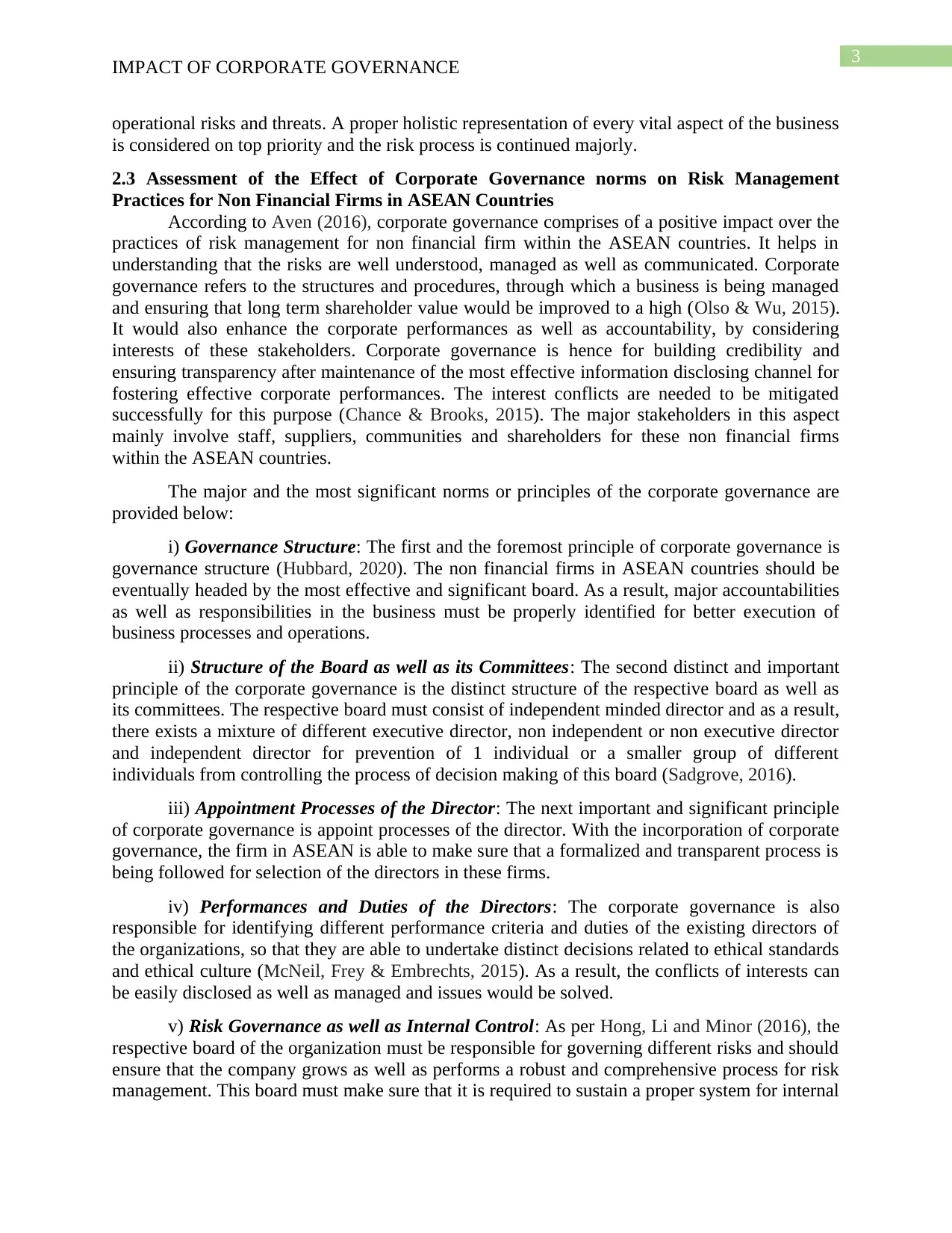
3
IMPACT OF CORPORATE GOVERNANCE
operational risks and threats. A proper holistic representation of every vital aspect of the business
is considered on top priority and the risk process is continued majorly.
2.3 Assessment of the Effect of Corporate Governance norms on Risk Management
Practices for Non Financial Firms in ASEAN Countries
According to Aven (2016), corporate governance comprises of a positive impact over the
practices of risk management for non financial firm within the ASEAN countries. It helps in
understanding that the risks are well understood, managed as well as communicated. Corporate
governance refers to the structures and procedures, through which a business is being managed
and ensuring that long term shareholder value would be improved to a high (Olso & Wu, 2015).
It would also enhance the corporate performances as well as accountability, by considering
interests of these stakeholders. Corporate governance is hence for building credibility and
ensuring transparency after maintenance of the most effective information disclosing channel for
fostering effective corporate performances. The interest conflicts are needed to be mitigated
successfully for this purpose (Chance & Brooks, 2015). The major stakeholders in this aspect
mainly involve staff, suppliers, communities and shareholders for these non financial firms
within the ASEAN countries.
The major and the most significant norms or principles of the corporate governance are
provided below:
i) Governance Structure: The first and the foremost principle of corporate governance is
governance structure (Hubbard, 2020). The non financial firms in ASEAN countries should be
eventually headed by the most effective and significant board. As a result, major accountabilities
as well as responsibilities in the business must be properly identified for better execution of
business processes and operations.
ii) Structure of the Board as well as its Committees: The second distinct and important
principle of the corporate governance is the distinct structure of the respective board as well as
its committees. The respective board must consist of independent minded director and as a result,
there exists a mixture of different executive director, non independent or non executive director
and independent director for prevention of 1 individual or a smaller group of different
individuals from controlling the process of decision making of this board (Sadgrove, 2016).
iii) Appointment Processes of the Director: The next important and significant principle
of corporate governance is appoint processes of the director. With the incorporation of corporate
governance, the firm in ASEAN is able to make sure that a formalized and transparent process is
being followed for selection of the directors in these firms.
iv) Performances and Duties of the Directors: The corporate governance is also
responsible for identifying different performance criteria and duties of the existing directors of
the organizations, so that they are able to undertake distinct decisions related to ethical standards
and ethical culture (McNeil, Frey & Embrechts, 2015). As a result, the conflicts of interests can
be easily disclosed as well as managed and issues would be solved.
v) Risk Governance as well as Internal Control: As per Hong, Li and Minor (2016), the
respective board of the organization must be responsible for governing different risks and should
ensure that the company grows as well as performs a robust and comprehensive process for risk
management. This board must make sure that it is required to sustain a proper system for internal
IMPACT OF CORPORATE GOVERNANCE
operational risks and threats. A proper holistic representation of every vital aspect of the business
is considered on top priority and the risk process is continued majorly.
2.3 Assessment of the Effect of Corporate Governance norms on Risk Management
Practices for Non Financial Firms in ASEAN Countries
According to Aven (2016), corporate governance comprises of a positive impact over the
practices of risk management for non financial firm within the ASEAN countries. It helps in
understanding that the risks are well understood, managed as well as communicated. Corporate
governance refers to the structures and procedures, through which a business is being managed
and ensuring that long term shareholder value would be improved to a high (Olso & Wu, 2015).
It would also enhance the corporate performances as well as accountability, by considering
interests of these stakeholders. Corporate governance is hence for building credibility and
ensuring transparency after maintenance of the most effective information disclosing channel for
fostering effective corporate performances. The interest conflicts are needed to be mitigated
successfully for this purpose (Chance & Brooks, 2015). The major stakeholders in this aspect
mainly involve staff, suppliers, communities and shareholders for these non financial firms
within the ASEAN countries.
The major and the most significant norms or principles of the corporate governance are
provided below:
i) Governance Structure: The first and the foremost principle of corporate governance is
governance structure (Hubbard, 2020). The non financial firms in ASEAN countries should be
eventually headed by the most effective and significant board. As a result, major accountabilities
as well as responsibilities in the business must be properly identified for better execution of
business processes and operations.
ii) Structure of the Board as well as its Committees: The second distinct and important
principle of the corporate governance is the distinct structure of the respective board as well as
its committees. The respective board must consist of independent minded director and as a result,
there exists a mixture of different executive director, non independent or non executive director
and independent director for prevention of 1 individual or a smaller group of different
individuals from controlling the process of decision making of this board (Sadgrove, 2016).
iii) Appointment Processes of the Director: The next important and significant principle
of corporate governance is appoint processes of the director. With the incorporation of corporate
governance, the firm in ASEAN is able to make sure that a formalized and transparent process is
being followed for selection of the directors in these firms.
iv) Performances and Duties of the Directors: The corporate governance is also
responsible for identifying different performance criteria and duties of the existing directors of
the organizations, so that they are able to undertake distinct decisions related to ethical standards
and ethical culture (McNeil, Frey & Embrechts, 2015). As a result, the conflicts of interests can
be easily disclosed as well as managed and issues would be solved.
v) Risk Governance as well as Internal Control: As per Hong, Li and Minor (2016), the
respective board of the organization must be responsible for governing different risks and should
ensure that the company grows as well as performs a robust and comprehensive process for risk
management. This board must make sure that it is required to sustain a proper system for internal
Paraphrase This Document
Need a fresh take? Get an instant paraphrase of this document with our AI Paraphraser
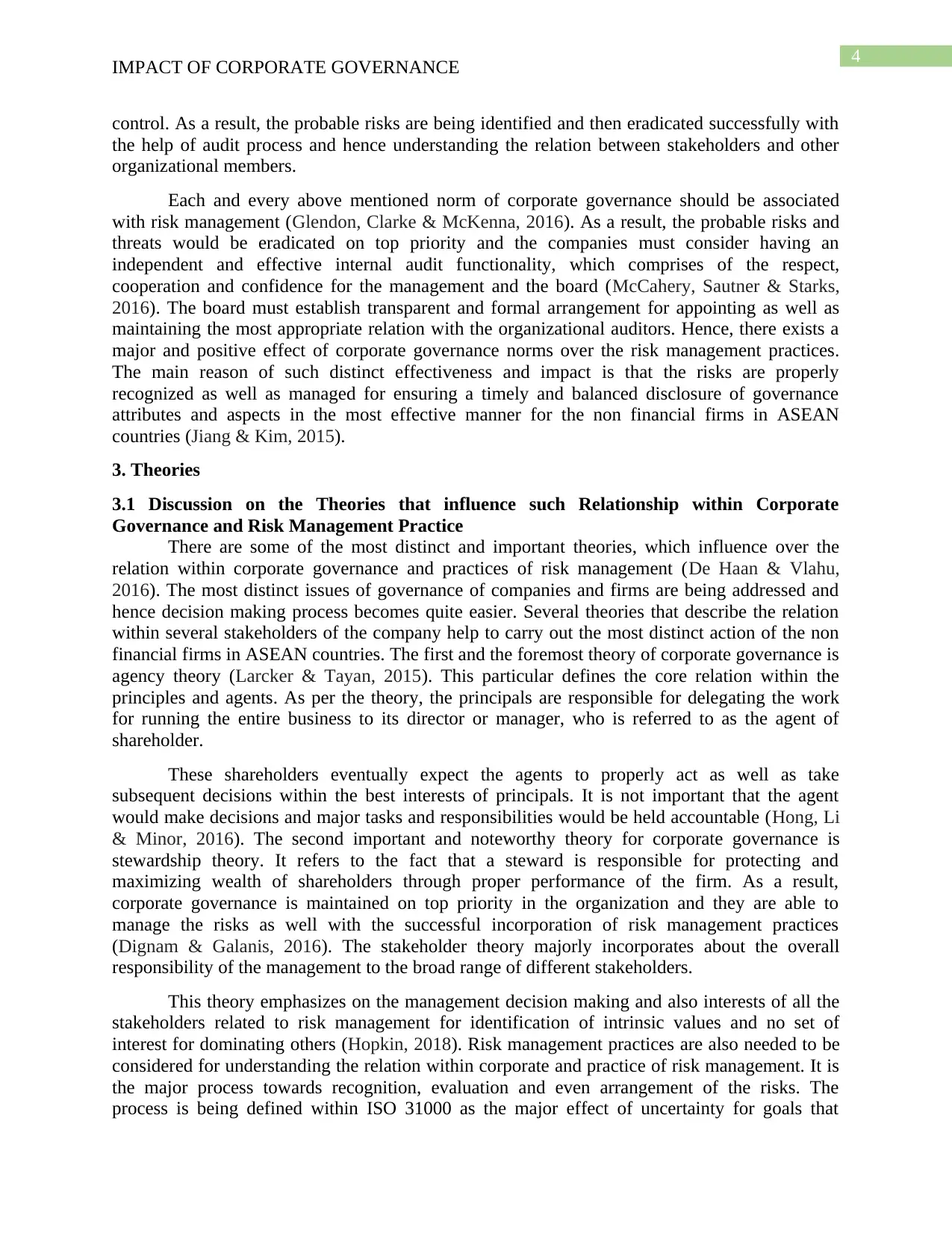
4
IMPACT OF CORPORATE GOVERNANCE
control. As a result, the probable risks are being identified and then eradicated successfully with
the help of audit process and hence understanding the relation between stakeholders and other
organizational members.
Each and every above mentioned norm of corporate governance should be associated
with risk management (Glendon, Clarke & McKenna, 2016). As a result, the probable risks and
threats would be eradicated on top priority and the companies must consider having an
independent and effective internal audit functionality, which comprises of the respect,
cooperation and confidence for the management and the board (McCahery, Sautner & Starks,
2016). The board must establish transparent and formal arrangement for appointing as well as
maintaining the most appropriate relation with the organizational auditors. Hence, there exists a
major and positive effect of corporate governance norms over the risk management practices.
The main reason of such distinct effectiveness and impact is that the risks are properly
recognized as well as managed for ensuring a timely and balanced disclosure of governance
attributes and aspects in the most effective manner for the non financial firms in ASEAN
countries (Jiang & Kim, 2015).
3. Theories
3.1 Discussion on the Theories that influence such Relationship within Corporate
Governance and Risk Management Practice
There are some of the most distinct and important theories, which influence over the
relation within corporate governance and practices of risk management (De Haan & Vlahu,
2016). The most distinct issues of governance of companies and firms are being addressed and
hence decision making process becomes quite easier. Several theories that describe the relation
within several stakeholders of the company help to carry out the most distinct action of the non
financial firms in ASEAN countries. The first and the foremost theory of corporate governance is
agency theory (Larcker & Tayan, 2015). This particular defines the core relation within the
principles and agents. As per the theory, the principals are responsible for delegating the work
for running the entire business to its director or manager, who is referred to as the agent of
shareholder.
These shareholders eventually expect the agents to properly act as well as take
subsequent decisions within the best interests of principals. It is not important that the agent
would make decisions and major tasks and responsibilities would be held accountable (Hong, Li
& Minor, 2016). The second important and noteworthy theory for corporate governance is
stewardship theory. It refers to the fact that a steward is responsible for protecting and
maximizing wealth of shareholders through proper performance of the firm. As a result,
corporate governance is maintained on top priority in the organization and they are able to
manage the risks as well with the successful incorporation of risk management practices
(Dignam & Galanis, 2016). The stakeholder theory majorly incorporates about the overall
responsibility of the management to the broad range of different stakeholders.
This theory emphasizes on the management decision making and also interests of all the
stakeholders related to risk management for identification of intrinsic values and no set of
interest for dominating others (Hopkin, 2018). Risk management practices are also needed to be
considered for understanding the relation within corporate and practice of risk management. It is
the major process towards recognition, evaluation and even arrangement of the risks. The
process is being defined within ISO 31000 as the major effect of uncertainty for goals that
IMPACT OF CORPORATE GOVERNANCE
control. As a result, the probable risks are being identified and then eradicated successfully with
the help of audit process and hence understanding the relation between stakeholders and other
organizational members.
Each and every above mentioned norm of corporate governance should be associated
with risk management (Glendon, Clarke & McKenna, 2016). As a result, the probable risks and
threats would be eradicated on top priority and the companies must consider having an
independent and effective internal audit functionality, which comprises of the respect,
cooperation and confidence for the management and the board (McCahery, Sautner & Starks,
2016). The board must establish transparent and formal arrangement for appointing as well as
maintaining the most appropriate relation with the organizational auditors. Hence, there exists a
major and positive effect of corporate governance norms over the risk management practices.
The main reason of such distinct effectiveness and impact is that the risks are properly
recognized as well as managed for ensuring a timely and balanced disclosure of governance
attributes and aspects in the most effective manner for the non financial firms in ASEAN
countries (Jiang & Kim, 2015).
3. Theories
3.1 Discussion on the Theories that influence such Relationship within Corporate
Governance and Risk Management Practice
There are some of the most distinct and important theories, which influence over the
relation within corporate governance and practices of risk management (De Haan & Vlahu,
2016). The most distinct issues of governance of companies and firms are being addressed and
hence decision making process becomes quite easier. Several theories that describe the relation
within several stakeholders of the company help to carry out the most distinct action of the non
financial firms in ASEAN countries. The first and the foremost theory of corporate governance is
agency theory (Larcker & Tayan, 2015). This particular defines the core relation within the
principles and agents. As per the theory, the principals are responsible for delegating the work
for running the entire business to its director or manager, who is referred to as the agent of
shareholder.
These shareholders eventually expect the agents to properly act as well as take
subsequent decisions within the best interests of principals. It is not important that the agent
would make decisions and major tasks and responsibilities would be held accountable (Hong, Li
& Minor, 2016). The second important and noteworthy theory for corporate governance is
stewardship theory. It refers to the fact that a steward is responsible for protecting and
maximizing wealth of shareholders through proper performance of the firm. As a result,
corporate governance is maintained on top priority in the organization and they are able to
manage the risks as well with the successful incorporation of risk management practices
(Dignam & Galanis, 2016). The stakeholder theory majorly incorporates about the overall
responsibility of the management to the broad range of different stakeholders.
This theory emphasizes on the management decision making and also interests of all the
stakeholders related to risk management for identification of intrinsic values and no set of
interest for dominating others (Hopkin, 2018). Risk management practices are also needed to be
considered for understanding the relation within corporate and practice of risk management. It is
the major process towards recognition, evaluation and even arrangement of the risks. The
process is being defined within ISO 31000 as the major effect of uncertainty for goals that
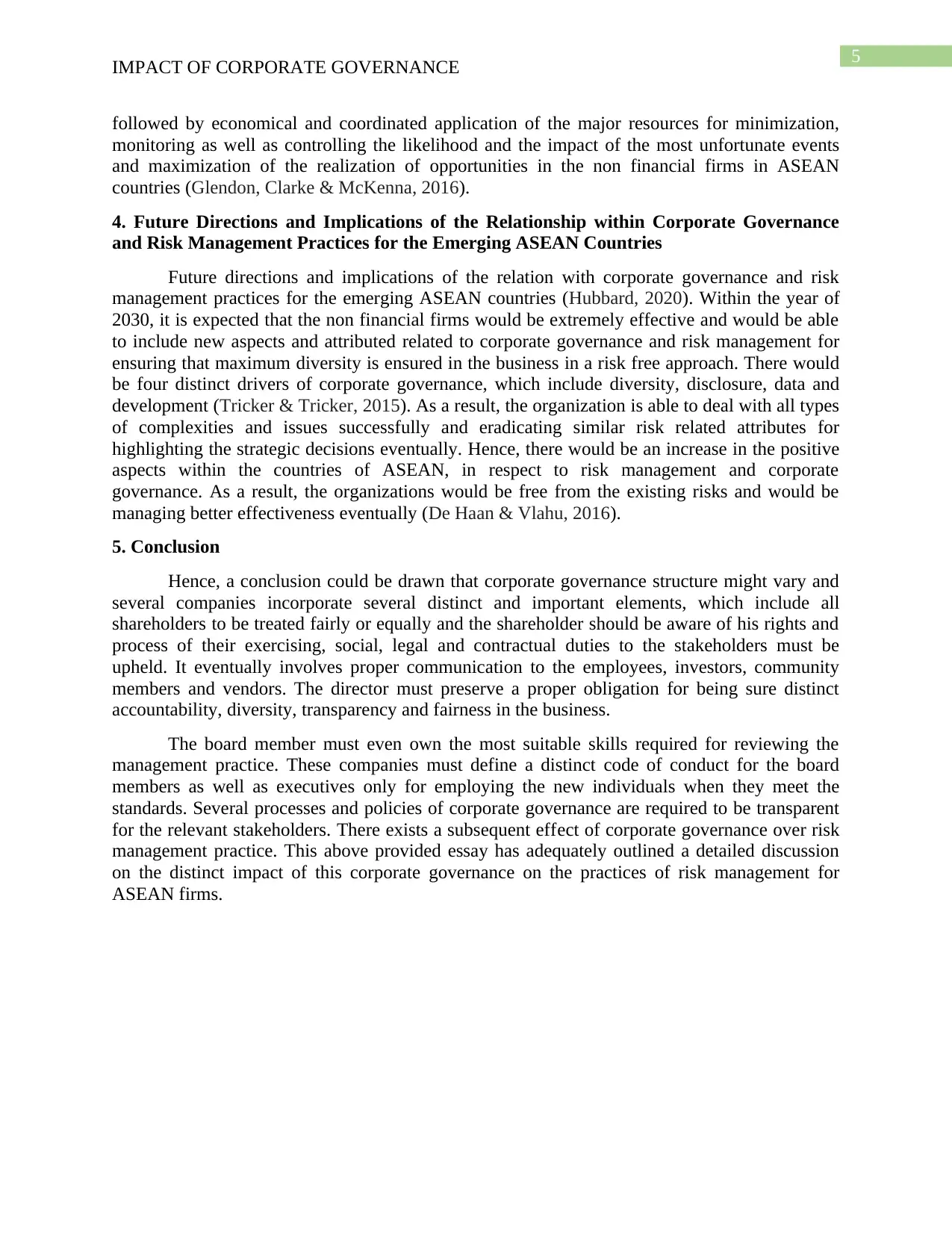
5
IMPACT OF CORPORATE GOVERNANCE
followed by economical and coordinated application of the major resources for minimization,
monitoring as well as controlling the likelihood and the impact of the most unfortunate events
and maximization of the realization of opportunities in the non financial firms in ASEAN
countries (Glendon, Clarke & McKenna, 2016).
4. Future Directions and Implications of the Relationship within Corporate Governance
and Risk Management Practices for the Emerging ASEAN Countries
Future directions and implications of the relation with corporate governance and risk
management practices for the emerging ASEAN countries (Hubbard, 2020). Within the year of
2030, it is expected that the non financial firms would be extremely effective and would be able
to include new aspects and attributed related to corporate governance and risk management for
ensuring that maximum diversity is ensured in the business in a risk free approach. There would
be four distinct drivers of corporate governance, which include diversity, disclosure, data and
development (Tricker & Tricker, 2015). As a result, the organization is able to deal with all types
of complexities and issues successfully and eradicating similar risk related attributes for
highlighting the strategic decisions eventually. Hence, there would be an increase in the positive
aspects within the countries of ASEAN, in respect to risk management and corporate
governance. As a result, the organizations would be free from the existing risks and would be
managing better effectiveness eventually (De Haan & Vlahu, 2016).
5. Conclusion
Hence, a conclusion could be drawn that corporate governance structure might vary and
several companies incorporate several distinct and important elements, which include all
shareholders to be treated fairly or equally and the shareholder should be aware of his rights and
process of their exercising, social, legal and contractual duties to the stakeholders must be
upheld. It eventually involves proper communication to the employees, investors, community
members and vendors. The director must preserve a proper obligation for being sure distinct
accountability, diversity, transparency and fairness in the business.
The board member must even own the most suitable skills required for reviewing the
management practice. These companies must define a distinct code of conduct for the board
members as well as executives only for employing the new individuals when they meet the
standards. Several processes and policies of corporate governance are required to be transparent
for the relevant stakeholders. There exists a subsequent effect of corporate governance over risk
management practice. This above provided essay has adequately outlined a detailed discussion
on the distinct impact of this corporate governance on the practices of risk management for
ASEAN firms.
IMPACT OF CORPORATE GOVERNANCE
followed by economical and coordinated application of the major resources for minimization,
monitoring as well as controlling the likelihood and the impact of the most unfortunate events
and maximization of the realization of opportunities in the non financial firms in ASEAN
countries (Glendon, Clarke & McKenna, 2016).
4. Future Directions and Implications of the Relationship within Corporate Governance
and Risk Management Practices for the Emerging ASEAN Countries
Future directions and implications of the relation with corporate governance and risk
management practices for the emerging ASEAN countries (Hubbard, 2020). Within the year of
2030, it is expected that the non financial firms would be extremely effective and would be able
to include new aspects and attributed related to corporate governance and risk management for
ensuring that maximum diversity is ensured in the business in a risk free approach. There would
be four distinct drivers of corporate governance, which include diversity, disclosure, data and
development (Tricker & Tricker, 2015). As a result, the organization is able to deal with all types
of complexities and issues successfully and eradicating similar risk related attributes for
highlighting the strategic decisions eventually. Hence, there would be an increase in the positive
aspects within the countries of ASEAN, in respect to risk management and corporate
governance. As a result, the organizations would be free from the existing risks and would be
managing better effectiveness eventually (De Haan & Vlahu, 2016).
5. Conclusion
Hence, a conclusion could be drawn that corporate governance structure might vary and
several companies incorporate several distinct and important elements, which include all
shareholders to be treated fairly or equally and the shareholder should be aware of his rights and
process of their exercising, social, legal and contractual duties to the stakeholders must be
upheld. It eventually involves proper communication to the employees, investors, community
members and vendors. The director must preserve a proper obligation for being sure distinct
accountability, diversity, transparency and fairness in the business.
The board member must even own the most suitable skills required for reviewing the
management practice. These companies must define a distinct code of conduct for the board
members as well as executives only for employing the new individuals when they meet the
standards. Several processes and policies of corporate governance are required to be transparent
for the relevant stakeholders. There exists a subsequent effect of corporate governance over risk
management practice. This above provided essay has adequately outlined a detailed discussion
on the distinct impact of this corporate governance on the practices of risk management for
ASEAN firms.
⊘ This is a preview!⊘
Do you want full access?
Subscribe today to unlock all pages.

Trusted by 1+ million students worldwide
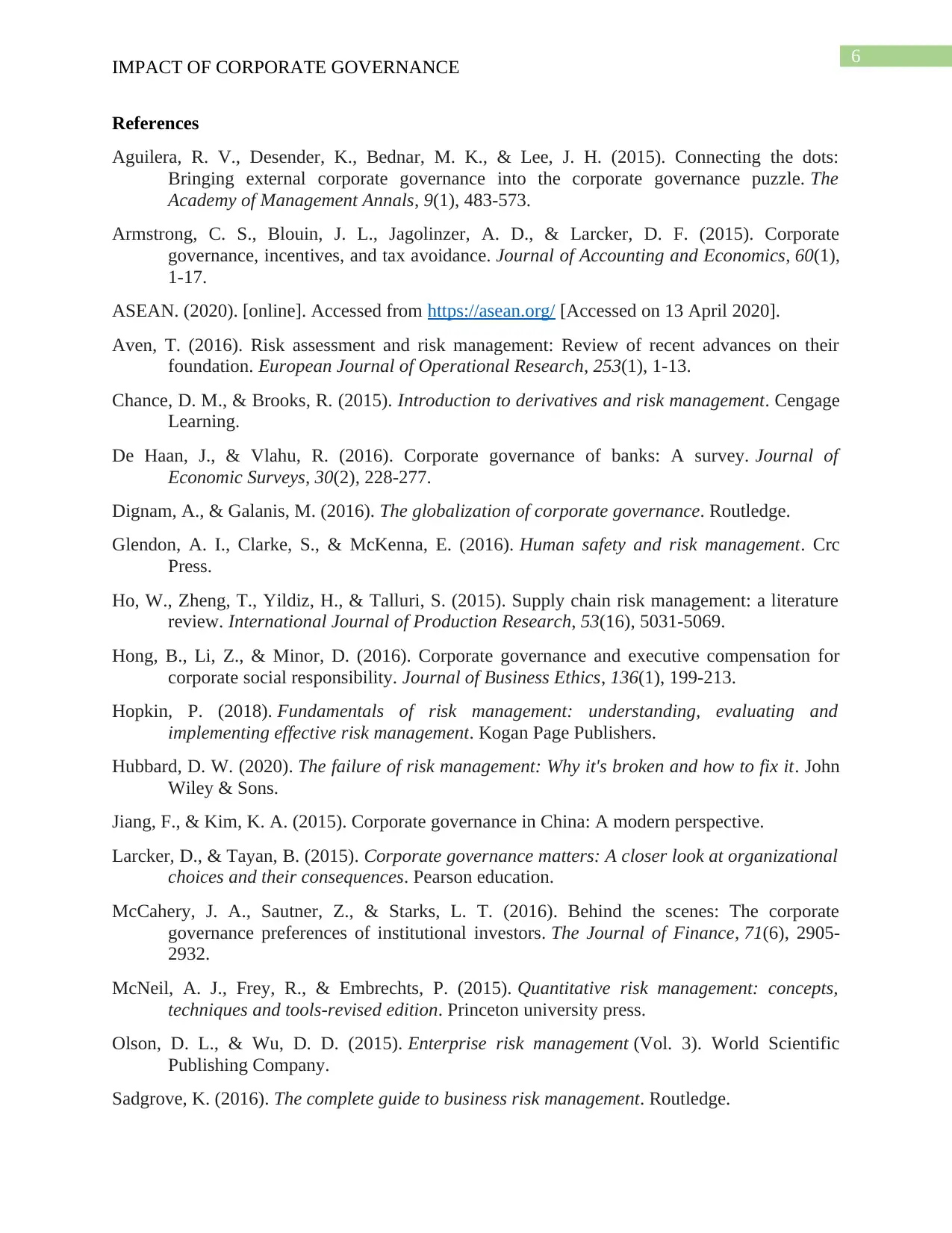
6
IMPACT OF CORPORATE GOVERNANCE
References
Aguilera, R. V., Desender, K., Bednar, M. K., & Lee, J. H. (2015). Connecting the dots:
Bringing external corporate governance into the corporate governance puzzle. The
Academy of Management Annals, 9(1), 483-573.
Armstrong, C. S., Blouin, J. L., Jagolinzer, A. D., & Larcker, D. F. (2015). Corporate
governance, incentives, and tax avoidance. Journal of Accounting and Economics, 60(1),
1-17.
ASEAN. (2020). [online]. Accessed from https://asean.org/ [Accessed on 13 April 2020].
Aven, T. (2016). Risk assessment and risk management: Review of recent advances on their
foundation. European Journal of Operational Research, 253(1), 1-13.
Chance, D. M., & Brooks, R. (2015). Introduction to derivatives and risk management. Cengage
Learning.
De Haan, J., & Vlahu, R. (2016). Corporate governance of banks: A survey. Journal of
Economic Surveys, 30(2), 228-277.
Dignam, A., & Galanis, M. (2016). The globalization of corporate governance. Routledge.
Glendon, A. I., Clarke, S., & McKenna, E. (2016). Human safety and risk management. Crc
Press.
Ho, W., Zheng, T., Yildiz, H., & Talluri, S. (2015). Supply chain risk management: a literature
review. International Journal of Production Research, 53(16), 5031-5069.
Hong, B., Li, Z., & Minor, D. (2016). Corporate governance and executive compensation for
corporate social responsibility. Journal of Business Ethics, 136(1), 199-213.
Hopkin, P. (2018). Fundamentals of risk management: understanding, evaluating and
implementing effective risk management. Kogan Page Publishers.
Hubbard, D. W. (2020). The failure of risk management: Why it's broken and how to fix it. John
Wiley & Sons.
Jiang, F., & Kim, K. A. (2015). Corporate governance in China: A modern perspective.
Larcker, D., & Tayan, B. (2015). Corporate governance matters: A closer look at organizational
choices and their consequences. Pearson education.
McCahery, J. A., Sautner, Z., & Starks, L. T. (2016). Behind the scenes: The corporate
governance preferences of institutional investors. The Journal of Finance, 71(6), 2905-
2932.
McNeil, A. J., Frey, R., & Embrechts, P. (2015). Quantitative risk management: concepts,
techniques and tools-revised edition. Princeton university press.
Olson, D. L., & Wu, D. D. (2015). Enterprise risk management (Vol. 3). World Scientific
Publishing Company.
Sadgrove, K. (2016). The complete guide to business risk management. Routledge.
IMPACT OF CORPORATE GOVERNANCE
References
Aguilera, R. V., Desender, K., Bednar, M. K., & Lee, J. H. (2015). Connecting the dots:
Bringing external corporate governance into the corporate governance puzzle. The
Academy of Management Annals, 9(1), 483-573.
Armstrong, C. S., Blouin, J. L., Jagolinzer, A. D., & Larcker, D. F. (2015). Corporate
governance, incentives, and tax avoidance. Journal of Accounting and Economics, 60(1),
1-17.
ASEAN. (2020). [online]. Accessed from https://asean.org/ [Accessed on 13 April 2020].
Aven, T. (2016). Risk assessment and risk management: Review of recent advances on their
foundation. European Journal of Operational Research, 253(1), 1-13.
Chance, D. M., & Brooks, R. (2015). Introduction to derivatives and risk management. Cengage
Learning.
De Haan, J., & Vlahu, R. (2016). Corporate governance of banks: A survey. Journal of
Economic Surveys, 30(2), 228-277.
Dignam, A., & Galanis, M. (2016). The globalization of corporate governance. Routledge.
Glendon, A. I., Clarke, S., & McKenna, E. (2016). Human safety and risk management. Crc
Press.
Ho, W., Zheng, T., Yildiz, H., & Talluri, S. (2015). Supply chain risk management: a literature
review. International Journal of Production Research, 53(16), 5031-5069.
Hong, B., Li, Z., & Minor, D. (2016). Corporate governance and executive compensation for
corporate social responsibility. Journal of Business Ethics, 136(1), 199-213.
Hopkin, P. (2018). Fundamentals of risk management: understanding, evaluating and
implementing effective risk management. Kogan Page Publishers.
Hubbard, D. W. (2020). The failure of risk management: Why it's broken and how to fix it. John
Wiley & Sons.
Jiang, F., & Kim, K. A. (2015). Corporate governance in China: A modern perspective.
Larcker, D., & Tayan, B. (2015). Corporate governance matters: A closer look at organizational
choices and their consequences. Pearson education.
McCahery, J. A., Sautner, Z., & Starks, L. T. (2016). Behind the scenes: The corporate
governance preferences of institutional investors. The Journal of Finance, 71(6), 2905-
2932.
McNeil, A. J., Frey, R., & Embrechts, P. (2015). Quantitative risk management: concepts,
techniques and tools-revised edition. Princeton university press.
Olson, D. L., & Wu, D. D. (2015). Enterprise risk management (Vol. 3). World Scientific
Publishing Company.
Sadgrove, K. (2016). The complete guide to business risk management. Routledge.
Paraphrase This Document
Need a fresh take? Get an instant paraphrase of this document with our AI Paraphraser

7
IMPACT OF CORPORATE GOVERNANCE
Tricker, R. B., & Tricker, R. I. (2015). Corporate governance: Principles, policies, and
practices. Oxford University Press.
Yermack, D. (2017). Corporate governance and blockchains. Review of Finance, 21(1), 7-31.
IMPACT OF CORPORATE GOVERNANCE
Tricker, R. B., & Tricker, R. I. (2015). Corporate governance: Principles, policies, and
practices. Oxford University Press.
Yermack, D. (2017). Corporate governance and blockchains. Review of Finance, 21(1), 7-31.
1 out of 8
Related Documents
Your All-in-One AI-Powered Toolkit for Academic Success.
+13062052269
info@desklib.com
Available 24*7 on WhatsApp / Email
![[object Object]](/_next/static/media/star-bottom.7253800d.svg)
Unlock your academic potential
Copyright © 2020–2025 A2Z Services. All Rights Reserved. Developed and managed by ZUCOL.





